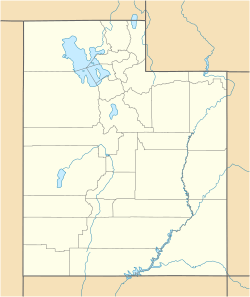Great Basin Research Station Historic District facts for kids
Quick facts for kids |
|
|
Great Basin Research Station Historic District
|
|
| Nearest city | Ephraim, Utah |
|---|---|
| Area | 71.9 acres (0.291 km2) |
| Built | 1912-16; 1933-36 |
| Built by | Civilian Conservation Corps |
| Architect | U.S.F.S. architects |
| Architectural style | Bungalow/craftsman, Colonial Revival, Forest Service Standards |
| NRHP reference No. | 96000678 |
| Added to NRHP | June 28, 1996 |
The Great Basin Research Station Historic District is a special place located in Ephraim Canyon, close to Ephraim, Utah. It's known as a historic district, which means it's an important area with buildings and structures that have a lot of history. This district was officially added to the National Register of Historic Places in 1996, recognizing its historical value.
Contents
What is the Great Basin Research Station?
The Great Basin Research Station is not just one spot; it's made up of two separate areas, about three miles apart. These areas were built at different times, mainly between 1912 and 1916, and then again from 1933 to 1936. The buildings show different styles, like Bungalow/Craftsman and Colonial Revival, and some follow specific designs used by the U.S. Forest Service.
Headquarters Complex
One part of the district is the Headquarters complex. This is where the main offices and facilities of the research station were located. You can find it on Forest Road 0053, which is off Ephraim Canyon Road. This area might also be called the Great Basin Station.
Alpine Cabin Complex
About three miles east of the Headquarters is the Alpine Cabin complex. This is another group of buildings that were part of the research station. Both the Headquarters and the Alpine Cabin areas were important for the work done here.
Why Was It Built?
The Great Basin Experimental Range was created by the United States Forest Service in 1912. Its main purpose was to study important issues related to forestry and how water flows through the land, which is called watershed management. Scientists and researchers worked here to understand how to best manage forests and protect water resources.
Who Built It?
Many of the buildings at both the Headquarters and the Alpine Cabin complexes were constructed by the Civilian Conservation Corps (CCC). The CCC was a program during the 1930s where young men worked on conservation projects across the country. They helped build many important structures in national forests and parks. Architects from the U.S. Forest Service also designed some of the buildings.
What's in the District?
The Great Basin Research Station Historic District covers about 71.9 acres (about 0.29 square kilometers). It includes several important historical elements:
- Buildings: There are 10 original buildings at the Headquarters and three at the Alpine Cabin that are considered historically important.
- Structures: At the Headquarters, you can find three important structures: a tennis court, an amphitheater (an outdoor stage area), and a tent frame.
- Objects: There are also three historical objects: a flagpole, a stone bench, and a water fountain.
- Archaeological Site: One archaeological site is also part of the district, which means there are remains of past human activity that are important to study.
Some buildings that were once part of the district have been taken down over time. Today, only their foundations remain, like those of a barn and a garage.
Location and Other Names
The district is located about eight miles (13 kilometers) east of Ephraim, Utah, within what is now the Manti-La Sal National Forest. The road leading to it, Ephraim Canyon Road, used to be part of Utah State Route 29. Besides its official name, the district has also been known as the Great Basin Environmental Education Center and the Great Basin Experimental Range-U.S.F.S.#BS-998.


